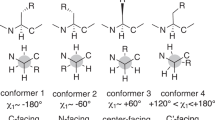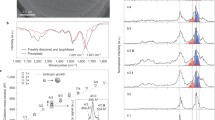Abstract
Cross-β amyloid fibrils and membrane-bound β-barrels are two important classes of β-sheet proteins. To investigate whether there are systematic differences in the backbone and sidechain conformations of these two families of proteins, here we analyze the 13C chemical shifts of 17 amyloid proteins and 7 β-barrel membrane proteins whose high-resolution structures have been determined by NMR. These 24 proteins contain 373 β-sheet residues in amyloid fibrils and 521 β-sheet residues in β-barrel membrane proteins. The 13C chemical shifts are shown in 2D 13C–13C correlation maps, and the amino acid residues are categorized by two criteria: (1) whether they occur in β-strand segments or in loops and turns; (2) whether they are water-exposed or dry, facing other residues or lipids. We also examine the abundance of each amino acid in amyloid proteins and β-barrels and compare the sidechain rotameric populations. The 13C chemical shifts indicate that hydrophobic methyl-rich residues and aromatic residues exhibit larger static sidechain conformational disorder in amyloid fibrils than in β-barrels. In comparison, hydroxyl- and amide-containing polar residues have more ordered sidechains and more ordered backbones in amyloid fibrils than in β-barrels. These trends can be explained by steric zipper interactions between β-sheet planes in cross-β fibrils, and by the interactions of β-barrel residues with lipid and water in the membrane. These conformational trends should be useful for structural analysis of amyloid fibrils and β-barrels based principally on NMR chemical shifts.









Similar content being viewed by others
Data availability
The complete chemical shift datasets analyzed in the current study are available from Mei Hong at meihong@mit.edu upon request.
References
Andreas LB et al (2016) Structure of fully protonated proteins by proton-detected magic-angle spinning NMR. Proc Natl Acad Sci USA 113:9187–9192
Bertini I, Gonnelli L, Luchinat C, Mao J, Nesi A (2011) A new structural model of Aβ40 fibrils. J Am Chem Soc 133:16013–16022
Colvin MT et al (2016) Atomic resolution structure of monomorphic Aβ42 amyloid fibrils. J Am Chem Soc 138:9663–9674
Consortium TU (2018) UniProt: a worldwide hub of protein knowledge. Nucleic Acids Res 47:D506–D515
Dregni AJ et al (2019) In vitro 0N4R tau fibrils contain a monomorphic β-sheet core enclosed by dynamically heterogeneous fuzzy coat segments. Proc Natl Acad Sci 116:16357
Dutta SK, Yao Y, Marassi FM (2017) Structural insights into the Yersinia pestis outer membrane protein ail in lipid bilayers. J Phys Chem B 121:7561–7570
Edrington TC, Kintz E, Goldberg JB, Tamm LK (2011) Structural basis for the interaction of lipopolysaccharide with outer membrane protein H (OprH) from Pseudomonas aeruginosa. J Biol Chem 286:39211–39223
Fitzpatrick AWP et al (2013) Atomic structure and hierarchical assembly of a cross-β amyloid fibril. Proc Natl Acad Sci 110:5468–5473
Gelenter MD et al (2019) The peptide hormone glucagon forms amyloid fibrils with two coexisting β-strand conformations. Nat Struct Mol Biol 26:592–598
Gremer L et al (2017) Fibril structure of amyloid-β(1–42) by cryo–electron microscopy. Science 358:116–119
Hagn F, Etzkorn M, Raschle T, Wagner G (2013) Optimized phospholipid bilayer nanodiscs facilitate high-resolution structure determination of membrane proteins. J Am Chem Soc 135:1919–1925
Han B, Liu Y, Ginzinger SW, Wishart DS (2011) SHIFTX2: significantly improved protein chemical shift prediction. J Biomol NMR 50:43
Hiller S, Garces RG, Malia TJ, Orekhov VY, Colombini M, Wagner G (2008) Solution structure of the integral human membrane protein VDAC-1 in detergent micelles. Science 321:1206–1210
Horst R, Stanczak P, Wüthrich K (2014) NMR polypeptide backbone conformation of the E. coli outer membrane protein W. Structure 22:1204–1209
Johansson MU, Alioth S, Hu K, Walser R, Koebnik R, Pervushin K (2007) A minimal transmembrane beta-barrel platform protein studied by nuclear magnetic resonance. Biochemistry 46:1128–1140
Laskowski R, Macarthur MW, Moss DS, Thornton J (1993) PROCHECK: a program to check the stereochemical quality of protein structures. J App Cryst 26:283–291
Laskowski RA, Rullmannn JA, MacArthur MW, Kaptein R, Thornton JM (1996) AQUA and PROCHECK-NMR: programs for checking the quality of protein structures solved by NMR. J Biomol NMR 8:477–486
Lee M et al (2017) Zinc-binding structure of a catalytic amyloid from solid-state NMR. Proc Natl Acad Sci 114:6191–6196
Liang B, Tamm LK (2007) Structure of outer membrane protein G by solution NMR spectroscopy. Proc Natl Acad Sci 104:16140–16145
Lovell SC, Word JM, Richardson JS, Richardson DC (2000) The penultimate rotamer library. Proteins 40:389–408
Lu J-X, Qiang W, Yau W-M, Schwieters Charles D, Meredith Stephen C, Tycko R (2013) Molecular structure of β-amyloid fibrils in Alzheimer’s disease brain. Tissue Cell 154:1257–1268
Mompeán M et al (2018) The structure of the necrosome RIPK1-RIPK3 core, a human hetero-amyloid signaling complex. Cell 173:1244-1253.e1210
Moon CP, Fleming KG (2011) Side-chain hydrophobicity scale derived from transmembrane protein folding into lipid bilayers. Proc Natl Acad Sci USA 108:10174–10177
Morcombe CR, Zilm KW (2003) Chemical shift referencing in MAS solid state NMR. J Magn Reson 162:479–486
Murray DT, Kato M, Lin Y, Thurber KR, Hung I, McKnight SL, Tycko R (2017) Structure of FUS protein fibrils and its relevance to self-assembly and phase separation of low-complexity domains. Cell 171:615-627.e616
Nagy-Smith K, Moore E, Schneider J, Tycko R (2015) Molecular structure of monomorphic peptide fibrils within a kinetically trapped hydrogel network. Proc Natl Acad Sci 112:9816–9821
Nelson R, Sawaya MR, Balbirnie M, Madsen AØ, Riekel C, Grothe R, Eisenberg D (2005) Structure of the cross-β spine of amyloid-like fibrils. Nature 435:773
Paravastu AK, Leapman RD, Yau W-M, Tycko R (2008) Molecular structural basis for polymorphism in Alzheimer’s β-amyloid fibrils. Proc Natl Acad Sci 105:18349–18354
Retel JS et al (2017) Structure of outer membrane protein G in lipid bilayers. Nat Commun 8:2073
Sawaya MR et al (2007) Atomic structures of amyloid cross-beta spines reveal varied steric zippers. Nature 447:453–457
Scheidt HA, Morgado I, Rothemund S, Huster D (2012) Dynamics of amyloid β fibrils revealed by solid-state NMR. J Biol Chem 287:2017–2021
Schütz AK et al (2015) Atomic-resolution three-dimensional structure of amyloid β fibrils bearing the osaka mutation. Angew Chem Int Ed 54:331–335
Sgourakis NG, Yau WM, Qiang W (2015) Modeling an in-register, parallel “iowa” aβ fibril structure using solid-state NMR data from labeled samples with rosetta. Structure 23:216–227
Shahid SA, Bardiaux B, Franks WT, Krabben L, Habeck M, van Rossum BJ, Linke D (2012) Membrane-protein structure determination by solid-state NMR spectroscopy of microcrystals. Nat Methods 9:1212–1217
Shen Y, Bax A (2010) SPARTA+: a modest improvement in empirical NMR chemical shift prediction by means of an artificial neural network. J Biomol NMR 48:13–22
Shen Y, Bax A (2013) Protein backbone and sidechain torsion angles predicted from NMR chemical shifts using artificial neural networks. J Biomol NMR 56:227–241
Shen Y, Delaglio F, Cornilescu G, Bax A (2009) TALOS+: a hybrid method for predicting protein backbone torsion angles from NMR chemical shifts. J Biomol NMR 44:213–223
Shen Y et al (2008) Consistent blind protein structure generation from NMR chemical shift data. Proc Natl Acad Sci USA 105:4685–4690
Skora L, Zweckstetter M (2012) Determination of amyloid core structure using chemical shifts. Protein Sci 21:1948–1953
Smith AA, Testori E, Cadalbert R, Meier BH, Ernst M (2016) Characterization of fibril dynamics on three timescales by solid-state NMR. J Biomol NMR 65:171–191
Spera S, Bax A (1991) Empirical correlation between protein backbone conformation and Ca and Cb 13C nuclear magnetic resonance chemical shifts. J Am Chem Soc 113:5490–5492
Su Y, Doherty T, Waring AJ, Ruchala P, Hong M (2009) Roles of arginine and lysine residues in the translocation of a cell-penetrating peptide from (13)C, (31)P, and (19)F solid-state NMR. Biochemistry 48:4587–4595
Tang M, Waring AJ, Hong M (2007) Phosphate-mediated arginine insertion into lipid membranes and pore formation by a cationic membrane peptide from solid-state NMR. J Am Chem Soc 129:11438–11446
Tuttle MD et al (2016) Solid-state NMR structure of a pathogenic fibril of full-length human α-synuclein. Nat Struct Mol Biol 23:409
Ulrich EL et al (2008) BioMagResBank. Nucleic Acids Res 36:D402-408
van der Wel PCA, Lewandowski JR, Griffin RG (2007) Solid-state NMR study of amyloid nanocrystals and fibrils formed by the peptide GNNQQNY from yeast prion protein Sup35p. J Am Chem Soc 129:5117–5130
Vranken WF, Rieping W (2009) Relationship between chemical shift value and accessible surface area for all amino acid atoms. BMC Struct Biol 9:20
Wälti MA et al (2016) Atomic-resolution structure of a disease-relevant Aβ(1–42) amyloid fibril. Proc Natl Acad Sci 113:E4976–E4984
Wasmer C, Lange A, Van Melckebeke H, Siemer AB, Riek R, Meier BH (2008) Amyloid fibrils of the HET-s(218–289) prion form a beta solenoid with a triangular hydrophobic core. Science 319:1523–1526
Wishart DS, Sykes BD (1994) The 13C chemical-shift index: a simple method for the identification of protein secondary structure using 13C chemical-shift data. J Biomol NMR 4:171–180
Wishart DS, Sykes BD, Richards FM (1991) Relationship between nuclear magnetic resonance chemical shift and protein secondary structure. J Mol Biol 222:311–333
Wishart DS, Sykes BD, Richards FM (1992) The chemical shift index: a fast and simple method for the assignment of protein secondary structure through NMR spectroscopy. Biochemistry 31:1647–1651
Wishart DS et al (1995) 1H, 13C, and 15N chemical shift referencing in biomolecular NMR. J Biomol NMR 6:135–140
Xiao Y et al (2015) Aβ(1–42) fibril structure illuminates self-recognition and replication of amyloid in Alzheimer’s disease. Nat Struct Mol Biol 22:499
Acknowledgements
This work is supported by NIH Grant AG059661 to M.H. and an NIH Ruth L. Kirschstein Individual National Research Service Award (1F31AI133989) to M.D.G.
Author information
Authors and Affiliations
Corresponding author
Additional information
Publisher's Note
Springer Nature remains neutral with regard to jurisdictional claims in published maps and institutional affiliations.
Rights and permissions
About this article
Cite this article
Somberg, N.H., Gelenter, M.D. & Hong, M. Comparative analysis of 13C chemical shifts of β-sheet amyloid proteins and outer membrane proteins. J Biomol NMR 75, 151–166 (2021). https://doi.org/10.1007/s10858-021-00364-y
Received:
Accepted:
Published:
Issue Date:
DOI: https://doi.org/10.1007/s10858-021-00364-y




